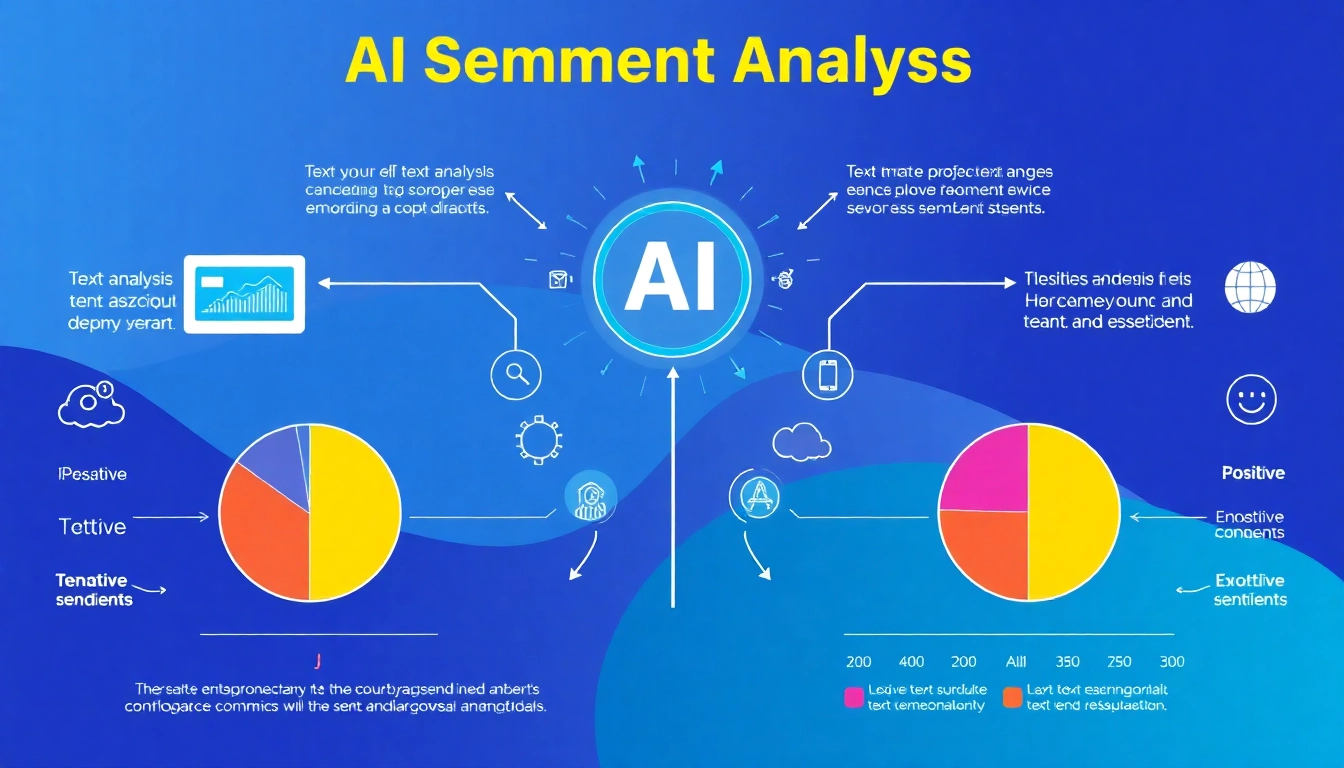Understanding AI Sentiment Analysis
Sentiment analysis represents a transformative capability in the realm of artificial intelligence, utilizing computational means to interpret human emotions as expressed through text. Whether analyzing customer reviews, social media posts, or user interactions, AI sentiment analysis can categorize sentiments as positive, negative, or neutral. This approach is invaluable for businesses seeking to gauge customer satisfaction and market trends. In this article, we’ll delve into the intricacies of AI sentiment analysis, its underlying technologies, numerous applications, and future prospects. For further insights into AI sentiment analysis, keep reading.
What is Sentiment Analysis?
Sentiment analysis, also known as opinion mining, is the process of extracting subjective information from text. It involves the use of natural language processing (NLP) and machine learning techniques to identify the sentiment conveyed by the writer. Key applications include analyzing customer feedback, monitoring brand reputation, and even assessing market movements based on social media chatter. The technology scans through massive volumes of text to pinpoint emotional undertones and assess the general sentiment towards a topic, product, or brand.
The Importance of Sentiment Analysis in Today’s Market
In an era where businesses are inundated with data, sentiment analysis has emerged as a crucial tool for understanding consumer behavior. Enterprises leverage this technology to draw actionable insights from customer interactions and feedback. Understanding whether sentiment trends are positive or negative provides companies with a competitive edge, allowing them to respond promptly to public perception and adapt their strategies accordingly.
How AI Enhances Sentiment Analysis Accuracy
AI-driven sentiment analysis significantly enhances the accuracy of sentiment detection by utilizing advanced algorithms that learn and evolve. Traditional methods often rely on predefined rules and keyword lists, which are often insufficient to capture the nuances of human language. AI enhances this by employing neural networks and machine learning techniques that incorporate context, slang, and even sarcasm into their analyses, thereby increasing the reliability of results.
Core Technologies Behind AI Sentiment Analysis
An Overview of Natural Language Processing
Natural Language Processing (NLP) is a subset of artificial intelligence that focuses on the interaction between computers and humans through natural language. NLP encompasses multiple challenges in understanding and generating human language, including parsing syntax, understanding semantics, and recognizing intent. In sentiment analysis, NLP techniques are pivotal for translating unstructured data—such as customer reviews—into structured data that can be easily analyzed for sentiment. NLP utilizes tokenization, stemming, lemmatization, and sentiment lexicons to process and classify text.
Machine Learning Algorithms for Sentiment Classification
Machine learning (ML) algorithms play a crucial role in improving sentiment analysis systems. Common ML approaches include:
- Supervised Learning: Models are trained on labeled datasets where sentiments are tagged. Algorithms like logistic regression, decision trees, and support vector machines (SVM) excel in this domain.
- Unsupervised Learning: When labeled data is scarce, clustering methods like K-means and hierarchical clustering help uncover patterns in sentiment without predefined tags.
- Deep Learning: Neural networks, specifically Recurrent Neural Networks (RNN) and Long Short-Term Memory networks (LSTM), have gained traction due to their ability to process sequences of text and maintain context.
Data Sources for Sentiment Analysis
The effectiveness of sentiment analysis is highly contingent on the data sources utilized. Typical sources include:
- Social Media: Platforms like Twitter, Facebook, and Instagram provide real-time public sentiment on topics ranging from brands to social issues.
- Customer Reviews: Websites such as Yelp, Amazon, and TripAdvisor offer a goldmine of qualitative feedback that can be analyzed for sentiment.
- Surveys and Polls: Structured feedback from customers can provide clear sentiment indicators when collected and analyzed effectively.
- News Articles and Blogs: Sentiment related to brands and trends can also be analyzed from media coverage, offering insights into public perception.
Applications of AI Sentiment Analysis in Business
Using Sentiment Analysis for Customer Feedback
Businesses increasingly utilize sentiment analysis to decipher customer feedback for improving products and services. By analyzing sentiment scores from different touchpoints, companies can detect dissatisfaction or delight among customers and proactively address concerns. For example, a negative sentiment spike in product reviews may prompt immediate investigation into underlying issues, leading to quicker resolutions.
Impact on Marketing Strategies
Understanding consumer sentiment enhances marketing strategies significantly. Businesses can tailor their campaigns not only towards positive sentiments but also to transform negative perceptions. Sentiment analysis provides insights into how customers perceive brand messaging and marketing content, allowing for real-time adjustments. Additionally, targeting consumers through positive sentiment-driven campaigns can improve engagement rates significantly.
Case Studies of Successful AI Implementation
Several organizations have successfully implemented sentiment analysis, with measurable results:
- Netflix: Utilized sentiment analysis to gauge viewer reactions to its shows, tailoring content recommendations and producing more engaging original content based on viewer preferences.
- Walmart: Applied sentiment analysis on social media data to inform inventory decisions, ensuring popular products remained in stock based on real-time customer discussions.
- H&M: Implemented sentiment analysis from customer feedback to guide product design decisions, ensuring alignments with market trends and consumer preferences.
Choosing the Right AI Sentiment Analysis Tools
Factors to Consider When Selecting Tools
When opting for sentiment analysis tools, businesses should consider several factors to ensure they select the right solution:
- Accuracy: The primary concern should be the tool’s ability to accurately classify sentiments.
- Integration: Tools should integrate seamlessly into existing systems or workflows.
- Scalability: As data volumes grow, tools must maintain performance efficiency.
- Cost: Budgetary constraints will influence whether businesses choose free tools or premium subscriptions.
Top Free and Paid AI Sentiment Analysis Software
There is an array of sentiment analysis tools available, both free and paid. Here are some popular options:
- Free Tools:
- Google Cloud Natural Language API – A powerful API for analyzing sentiment from text.
- TextBlob – A Python library that simplifies text processing and sentiment analysis.
- VADER Sentiment Analysis – Specifically designed for social media text analysis and short content.
- Paid Tools:
- IBM Watson Natural Language Understanding – Offers advanced capabilities with deep insights into sentiment and emotion.
- Lexalytics – Provides on-premise and cloud solutions for comprehensive sentiment analysis.
- Brandwatch – A robust platform for social media monitoring and sentiment analysis.
Comparative Analysis of Leading Tools
When evaluating sentiment analysis tools, it’s important to conduct comparative analyses on features, usability, and pricing:
| Tool | Accuracy | Cost | Integration | Scalability |
|---|---|---|---|---|
| IBM Watson | High | $$$ | Excellent | High |
| TextBlob | Medium | Free | Moderate | Low |
| Brandwatch | High | $$$ | Excellent | Very High |
Future Trends in AI Sentiment Analysis
Generative AI and Its Role in Sentiment Analysis
Generative AI is rapidly transforming how sentiment analysis is approached. By leveraging context-aware models, generative AI can facilitate improved sentiment classification based on nuanced language cues and contextual information. Furthermore, this technology is adept at assembling and synthesizing responses based on identified sentiment trends, reinforcing engagement strategies in real time.
Predictions for AI in Emotional Intelligence
The future of AI sentiment analysis will likely intertwine more closely with the broader domain of emotional intelligence. AI systems are expected to evolve towards multifaceted emotional understanding, moving beyond mere sentiment categorization to deeper empathy and contextual understanding. This could revolutionize customer interactions and service models, making technology more relatable and human-like.
Challenges and Ethical Considerations
Despite its advancements, AI sentiment analysis faces challenges, particularly around accuracy and data privacy. Misinterpretations of sentiment can have severe repercussions for businesses, including reputational damage. Furthermore, ethical considerations surrounding data collection and use of personal information are paramount. Companies must ensure transparency and consent when analyzing customer sentiments to maintain trust.


